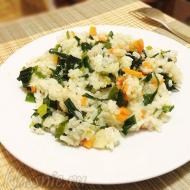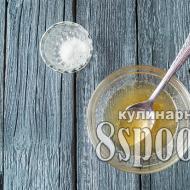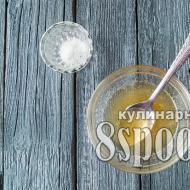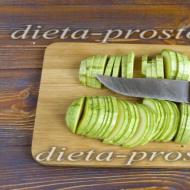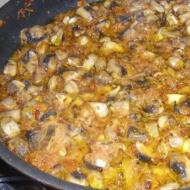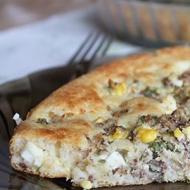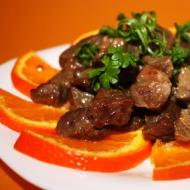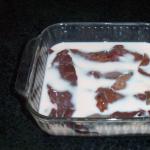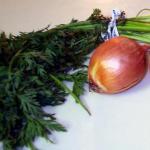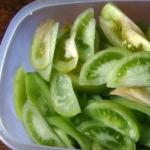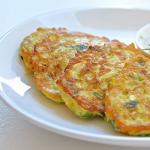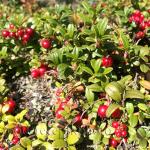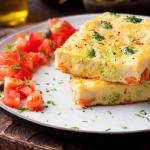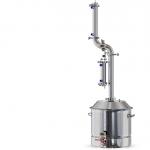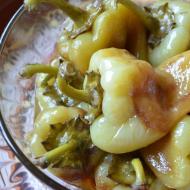
How is peanut butter different from jam. Peanut butter - benefits and harms, how it differs from jam and paste, how to make at home. Application in cooking
We know about many products that they were known thousands of years ago. Their relevance is not lost due to their unique properties. And one of these natural gifts are oils obtained from plants, fruits and roots. Ancient ancestors used them widely in their lives, and we also do not know how to live without them. Which is right, a good oil can work wonders. It should be in food, in the first aid kit, and in a cosmetic bag. And today we will talk about the topic - peanut butter.
Of course, we exaggerate a little when we say that the product should be in the first aid kit and in the cosmetic bag. It’s just that oil is useful not only for food, it works wonders in cosmetology, it also helps for therapeutic purposes. It just has to be there all the time. The benefits of peanut butter have been known since antiquity, it's time for you and me to become more educated in this regard. But first, let's find out some nuances, since questions often arise on this product.
Peanuts and their production
Peanuts grow in warm countries, in the southern regions, we know that they are eaten fresh or roasted. But our knowledge is narrowly focused, because various products are made from this gift of nature, and it is used even in cosmetology. Americans have been eating pasta for decades, which is very popular. Now in our country it is beginning to be sold, you can make it yourself at home. Made from peanuts and butter. And here many people have a question, but what is not the same peanut butter and paste, and then what is the difference? Everything is simple.
Butter is butter, paste is paste. We mislead ourselves by calling one another, we just got used to the fact that we spread butter on bread, peanut paste has a similar consistency, so often in our country it is called more traditionally for ourselves. In fact, peanut butter looks the same as the usual sunflower oil. Only has a more pronounced taste, refers to lean products. It is used for cooking and for cosmetic procedures and products. Pasta is made by grinding nuts with the same oil, and after that a creamy, brown mass is obtained.
What is the difference between peanut butter and jam is another frequently asked question. Again, these are two different products that are made differently. The technology for obtaining the first is most often pressing, cold or hot. The second product, namely jam, is the cooking of fruits. The process is long, besides, not only peanuts, but also fruits and berries can be used. The result is a dense, jelly-like product, the color of which will depend on the components.
It's more of a dessert than a frying, dressing or cosmetic product. All these are different products, with different taste, amount of nutrients and nutrients, calorie content. By the way, useful information for all women - peanut butter has a calorie content of 899 kcal, which is a very high figure.
It is interesting! Americans have been eating peanut butter and paste for a very long time as part of their diet. But in fact, the product can be treated, and at the beginning it was made in order to find a substitute for meat, and pasta was supposed to become an assistant to everyone who can be limited in food.
Hopefully now you will be more aware and understand how to consume peanut butter. It is eaten, seasoned with salads, used for frying, but also added to cosmetics, massaged with it, and used for body and hair masks. Pasta and jam are only eaten, they do not need to be smeared anywhere except bread. Let's now get acquainted with the beneficial properties of the product, find out what is in the composition, and after, of course, we will talk about a pleasant topic for all women - cosmetic use and effect.
It is interesting! What people don’t do with peanuts, they even throw them and take them to the moon. Yes, yes, these facts are documented. Astronaut Shepard took a nut to our satellite, an Australian resident threw it as much as 33 meters in length, with which he got into the Guinness Book of Records.
Peanut butter, what are its benefits and harms?
positive impact
The product has a whole range of useful properties, due to its unique composition.
- Helps heal wounds, abrasions, cuts.
- It saturates the body with vitamins, macro- and microelements, which improves our immunity, which means that we will get sick less.
- Has antibacterial properties.
- Helps lower cholesterol levels.
- Reduces blood sugar, which helps diabetics.
- It helps to recover very well when the body is worn out after stress, prolonged physical exertion.
- Serves as a preventive measure for a number of diseases.
- Useful properties of peanut butter in its pronounced positive cosmetic effect.
- Helps increase muscle tone and improve blood flow.
- It has a beneficial effect on our nervous system, stress is easier to tolerate, depression recedes.
- Stimulates the production of collagen, which makes the skin young, supple and toned.
- Used to treat eczema, herpes, skin inflammation, acne.
- If you use peanut butter regularly, you can improve liver function.
- It has a beneficial effect on the cardiovascular system, expels bile.
- Helps with anemia, blood diseases, hemophilia.
- It has a positive effect on men's health and strength.
- Amazing properties have been discovered by scientists who make peanut butter healing for the eyes. It should be eaten by those who suffer from cataracts, conjunctivitis, dystrophy, "night blindness".
Agree, you did not know about it, but the information above is amazing. This is natural protection, prevention, cosmetics and therapy. An unusual product, perhaps for you, because more often we use sunflower oil or olive oil, and only a few know what peanut butter is eaten with. But we have already said that at least with something. You can add it to pastries, salad, use for cooking. The oil is nutritious, it will saturate your body no worse than meat products, and make the dishes unusual, everyone will be surprised by your culinary abilities. To get a therapeutic effect, you need to drink three teaspoons of the product every day.
negative impact
In excess, oil can negatively affect your weight, as it is very high in calories. You also need to be careful for people with diseases of the joints, respiratory organs and those who have high blood clotting. Remember that the product is made from nuts, and they are allergens, so if there is a risk of individual intolerance, then it is better to refuse to use peanut butter.
Healing, rich and healthy composition of peanut butter - what is in the product?
Oil can have all its capabilities due to its composition. It contains vitamins - A, E, B4, B 3, B 6 and B 5, K, polyunsaturated - Omega 6 and monounsaturated acids, iron, zinc, manganese, magnesium, selenium, potassium. It also contains antioxidants. Scientists have found that the risk of developing cancer in people who eat this product is much less. Surprisingly, even overweight people with proper use can reduce weight.
As for the BJU of peanut butter, it is very high in fat - 99.9%. There are very few carbohydrates, which are presented in the form of coarse fibers, therefore they are usually not taken into account, the same situation is with proteins. In general, if you don’t know what BJU is, which lovers of healthy eating, nutritionists so often talk about now, then this is the percentage of proteins, fats, carbohydrates. Simply put, the nutritional value, which is often described on the packaging of all products, this also includes the percentage of fiber or coarse fibers, as well as calories. Based on these data, calculations are made for the diet to make it more balanced. Well, it's time to talk about an interesting topic for all girls - this is peanut butter and its use in cosmetology, and how and what you can do at home.
How to use oil for beauty and youth
For body
The oil can be rubbed into the skin like fashion lotions, and the effect will be like visiting a spa. You will notice how the body becomes more flexible, cellulite disappears, the skin shines, it looks healthy and young. The oil can be applied as a mask, rubbed after a shower, used for massage. You can get rid of spider veins, fine wrinkles, heal tissues from inflammation, and make scars less noticeable. Thanks to collagen, the skin will quickly regenerate, which can be seen in the rejuvenating result.
For information! People often wonder what peanut butter tastes like. It is pleasant, rich, gives a nut. If the oil is unrefined, then it will be more saturated, fragrant, if refined, then you will almost not feel the taste and smell, and this is why purification is carried out.
Peanut butter for face
It will act in the same way as on the body - by rubbing the product, applying it under the skin around the eyes, you will get rid of small facial wrinkles, shallow scars, rosacea, earthy color, peeling. Your face will become young and radiant. But remember that everything is good in moderation, as well as procedures in the form of masks, massages should be regular. Also, watch your diet, and, in general, your lifestyle.
Advice! You can add peanut oil to any cosmetic products - from face cream to hair mask.
Peanut oil for hair
For skin and hair, oil is like a breath of fresh air in a stuffy city, especially if they are dyed, constantly subjected to thermal perm or straightening. Hair masks 2-3 times a week will help get rid of dandruff, dryness, split ends. Hair will become filled, begin to shine, comb and style well. You will get rid of the "straw on the head" effect. The oil can be applied in its pure form and added to shampoos, balms, masks. It is also worth noting that you will get the best therapeutic and cosmetic effect from an unrefined product, that is, choose unrefined oil, yes, they do not fry on it, but it is ideal for home procedures.
We hope we have provided you with useful information. We advise you to try it once, and you will definitely see that the product is very useful.
All materials on the site are presented for informational purposes only. Before using any means, consultation with a doctor is MANDATORY!

In many foreign films, you can see a popular dish served for breakfast or as a snack - a peanut butter sandwich. Such a product is valued all over the world for its beneficial properties and incredible nutritional value, so you can find it in almost any large store. You can prepare such a mass at home, without worrying about the naturalness and safety of the components used. Consider how to cook pasta on your own and what is its wide benefit to humans.
Composition and calorie content of peanut butter
Today, there is far from one type of peanut butter, and each of them has its own characteristics. So, the compositions can differ both in the degree of grinding of the mass, and in a number of additional components. You can often find a product with the addition of candied fruits, other nuts, coconut flakes, or without added sugar.

Real paste is a ready-to-eat product, which is a well-ground mixture of pre-shelled and roasted peanuts, a small amount of salt, sugar and vegetable oil. To obtain a good structure, the introduction of safe stabilizers is acceptable. A good, high-quality paste should be homogeneous, creamy, with a pronounced taste and aroma of nuts. The calorie content of a natural pure product is about 600 kcal per 100 grams.
It is necessary to understand that on the shelves of stores you can also find not very high-quality products, which will contain many non-natural components - such a paste will most likely be just tasty, but not healthy at all. Therefore, when buying, be sure to pay attention to the composition.
Benefits of eating peanut butter
This pasta has gained immense popularity due to its nutritional value and a wide range of useful properties. Peanuts as the main ingredient provide this famous nutrition, and in this parameter it is not inferior to legumes. Walnut is a cholesterol-free vegetable protein with a high content of folic acid, iron, zinc, magnesium, potassium, iodine, calcium, vitamins B 1 and 2, A, E. This product is also rich in antioxidants that help protect the body from harmful effects free radicals.

The product is of great benefit for the cardiovascular system. Studies have shown that with regular consumption of walnuts as part of a correct diet, the risk of diseases is reduced by 15%. Unsaturated fats help lower cholesterol levels, and trace elements provide the basis for the normal functioning of all organs and systems. Considering that peanut butter is obtained by the method of cold processing, it retains all the benefits of the nut as much as possible. The product is also used for weight loss as a way to quickly and usefully saturate. There is also an opinion that the paste is able to increase the percentage of testosterone, thereby helping not only burn fat, but also build muscle mass, which is especially important for athletes.
Possible harm from the product
The main harm from the product in question lies in its increased allergenicity. So, the problem with the use of nuts is quite common, and if a person has an increased sensitivity to one of the species, then the others must either be completely abandoned or used with extreme caution. Also, do not forget about the high calorie content of the product, which can harm the figure if consumed excessively. This is where the dangers of a natural product end, but a poor-quality product created on the basis of harmful fats and artificial flavors can bring more extensive harm to the body. Unnatural paste has no benefit to humans.
How much peanut butter can you eat per day?

Given the high calorie content of the product, nutritionists do not recommend eating more than 1-2 tablespoons product during the day. If the risk of gaining weight does not bother you, then you can eat a lot more, but do not forget that such a product is highly allergenic and its consumption in large quantities can lead to severe skin and general body reactions. How exactly to take the paste - decide for yourself, because there are a lot of options.
What is the right way to eat it and where can I add it?
At the mention of such a product, many people have a question - what do they eat pasta with? In fact, there is nothing complicated here, since the scope of peanut mass is very wide. The easiest option is to simply spread it on sandwiches, but these are far from all the “opportunities”. So, this ingredient can be used in baking, becoming an ingredient in cakes or other desserts. Peanut butter cookies are especially good - the nut mass should not be baked in the oven, otherwise it will lose its properties, but as a filling for fastening the two halves of the cookie, it will fit just fine.
Some people like to just eat a few spoonfuls of pasta with a cup of tea or coffee, and this option is very common, and nut lovers will definitely appreciate it. But the use of the composition is not limited to sweet dishes alone, it can be found in recipes for sauces for risotto or pasta.
How to make peanut butter at home
The process of creating nut butter is not technologically complicated, but very interesting. Its peculiarity lies in the fact that it is enough just to interrupt the ingredients in a blender for a certain time, and in the process the peanuts will release oil, which will allow the crumbs to stop into a creamy mass. So, to create a paste you will need the following products:

- 400 grams of nuts;
- a tablespoon of vegetable oil;
- as much honey as a natural sweetener;
- and a pinch of salt.
The easiest option is to purchase an already roasted, peeled, but not salted nut, but you can implement all these processes yourself if you have the desire and time. The second step is to place the peanuts on a baking sheet in the oven for 5 minutes to dry more from excess moisture. After that, you can send the base of the dish to the blender and start grinding. Periodically, you need to look into the bowl and listen to the mass from the sides again to the center so that it is well worked out. A few minutes after the start of the process, you can add other components and continue beating and mixing until the desired consistency is obtained. If desired, other ingredients can be added to enrich the taste, for example, cinnamon, cocoa, dried fruits, candied fruits, etc.

Video recipe for making pasta with your own hands
Making peanut butter at home is a doable task that doesn't require a lot of different ingredients. It is imperative to prepare a blender, since it will take quite a long time to beat, and you can start cooking.
Contraindications for use
The first and most important limitation is allergy and individual intolerance to peanuts, which is quite common. Also, you will have to abandon the paste in the presence of gout, arthritis or arthrosis, diseases of the digestive tract.
It is better not to give such a tasty and healthy product to children, especially in large quantities. The reason lies, again, in the allergenicity of the product, it can provoke a variety of consequences from skin rashes to anaphylactic shock. During pregnancy and in childhood, it cannot be said that the use of pasta will be a strict contraindication in the absence of already known intolerance, but you need to eat the product as carefully and carefully as possible, in small quantities.
Peanut butter vs butter - what's the difference?

Peanut butter is the most valuable food product, since its nutritional value can be compared with sour-milk products and meat. It is made from "peanut" (peanut fruit). Oil production began in America in the 19th century, and then it became very popular in other countries.
1) Unrefined. This product has a deep reddish-brown hue, bright taste, and is produced in Asian countries.
2 and 3) Refined (deodorized and non-deodorized). Gained popularity both in America and in Europe. This herbal product has a light yellow hue, has a light taste and delicate aroma.
"Alive" refers to unrefined oil. It is this species that has the greatest nutritional value compared to other species; it is made by cold pressing. This type of plant product is often used to treat various diseases.

The excellent taste and nutritional value of the oil is due to its rich composition. The product made from "peanut" contains:
- fats that are easily absorbed by the body;
- essential fatty acids (this includes Omega 6 and 9, which contribute to the normalization of the body's immune defenses, the restoration of hormonal levels, the normalization of the genitourinary and nervous system);
- a complex of vitamins A, E, D, as well as group B (ensure the full functioning of most organs and systems, has an immunomodulatory, anti-inflammatory, regenerating effect).
The beneficial properties of aromatic peanut butter can be explained by the high content of both macronutrients and phospholipids, a whole complex of phytosterols, polyphenols, and betaine.
It should be noted that this product is an antibacterial, regenerating agent. Among the useful properties include the following abilities:
- has a tonic effect on the muscles, which has a positive effect on physical activity;
- lowers bad cholesterol;
- increases the body's resistance to disease, helps to restore internal strength after prolonged illness, as well as excessive physical exertion;
- helps restore a good night's sleep;
- is a natural stimulator of collagen formation;
- improves the general condition in diabetes mellitus;
- normalizes the functioning of the liver;
- contributes to the effective process of losing weight.
The use of peanut butter as a medicine is quite common in folk medicine. It perfectly treats eczema, poorly healing wounds, exudative diathesis, as well.

Like all plant products, peanut butter cannot be considered completely safe for the body. The benefits and harms of this "gift of nature" are listed in the instructions for its use, the entire list of both useful and harmful properties should be taken into account.
According to the results of numerous laboratory studies, a valuable peanut product is an excellent herbal remedy for the prevention of heart and vascular diseases. It helps to eliminate the symptoms of ischemia, will allow blood circulation to resume, and prevent the appearance of blood clots.
Oil made from peanut fruits has long been considered an excellent choleretic agent. Its components stimulate the process of bile secretion, contribute to the renewal of the structure of liver cells, relieve inflammation of the tissues of the biliary tract.
With diabetes, hemophilia, anemia, you can not do without the use of peanut oil, because it significantly improves the patient's condition. This herbal product will be of great benefit in such cases:
- in depressive states;
- with sleep disorders;
- with nervous tension;
- with some kidney diseases;
- with erectile disorders in men;
- with pathologies of the visual organs.
What harm to the body can cause the use of peanut butter
Everyone can determine the benefits and harms of peanut butter in a particular case. You should not use it in the manifestation of bronchial asthma, in the presence of chronic diseases of the joints, an increased number of platelets in the blood.
How to take peanut butter for healing
Due to the fact that peanut oil has a fairly high calorie content, it is recommended to use it for treatment in limited doses. Excessive use of it will not benefit the body, but rather harm it.
So how do you take peanut butter? It will be enough to take it three times a day for 5 ml (teaspoon). Such a volume of a plant product will provide the body with the required amount of vitamins, nutrients and macronutrients, and will allow you to quickly restore strength during excessive physical exertion.
Oddly enough, many women use peanut oil as an aid in weight loss. Such a product will perfectly replace animal fats, quickly saturate the body with everything necessary. Some fatty acids of this herbal product speed up the metabolism, which contributes to rapid weight loss.
calories
Before use, you should familiarize yourself with the value of peanut butter. Its calorie content is quite high - 900 Kcal, so it is recommended to use it for food for those who lead an active lifestyle and dream of losing weight. It not only gives a feeling of fullness, but also speeds up metabolism, tones muscle tissues.
The use of peanut oil in cosmetology
This type of oil is an excellent cosmetic product, because it contains betaine, polyphenol and “youth vitamins”, namely A and E. This herbal remedy moisturizes, nourishes the skin, enriches it with vitamins and minerals. The oil quickly penetrates the epidermis, making the skin supple.
Regular use of this therapeutic and cosmetic product will preserve the youthfulness of the skin, restore its protective functions. You can use the oil as part of masks, balms, creams, and cleansing products for hair and skin care (shampoo, soap).
How to make peanut butter at home - 3 ways

Today it is quite difficult to acquire a high-quality and useful product, but it is not so scary. Without much difficulty, you can cook homemade peanut butter, which in terms of its characteristics will not be inferior to store-bought counterparts.
There are several recipes for creating this healthy and tasty product.
1 way
Grind 2 cups of salted roasted nuts into fine crumbs using a blender. During grinding, gradually introduce 50 ml, a little salt and 70 gr. honey. Transfer the finished product to a jar or container, store homemade peanut butter in the refrigerator.
2 way
Grind a glass of roasted peanuts in a blender bowl, add 35 gr. honey and 50 ml of warm water. Beat all the ingredients until smooth, send the resulting mixture to the refrigerator for storage.
3 way
Grind 170 gr. roasted peanuts with a blender, pour in 50 ml refined, add 30 gr. powdered sugar along with a pinch of salt. Beat everything until a homogeneous mass is obtained. Store pasta in the refrigerator.

). Oddly enough, peanut butter turned out to be the closest in composition to such food. Like many other vegetable oils, peanut oil is made on an industrial scale by cold pressing (pressing). Subject to technology, the only ingredient that is added to, in addition to, in fact, the fruits of the peanut, is. Carefully selected peanuts (Runner variety is best) are shelled, then roasted in special ovens at very high temperatures and constantly shaking for uniform processing, then cooled as quickly as possible with intense blowing (if cooling is slow, this will lead to to severe fluid loss c). At the next stage, the grains are peeled and pre-crushed while removing the bitter core (it can be used as feed for poultry, and the husk is added to the diet of pigs).
Did you know? To obtain one kilogram of the finished product, approximately 2,200 pieces of selected peanuts will be needed.
Now it's time for crushing. In small industries, this happens with the help of a manual screw press, in large ones the process is fully automated. In the latter case, hydrogenated fats are also added to the oil for stabilization. They do not allow the finished paste to delaminate into fractions, but greatly reduce its useful properties. After crushing, the finished product is cooled, laid out in jars and sent for sale.
Important! Hydrogenated fats in the composition of the food product on the store shelf is a veiled name for the same palm oil, which in large quantities has a very detrimental effect on ours.
Quality peanut butter should not contain any cosmetic fragrances, preservatives or sweeteners. From the purchase of goods with a similar composition, it is better to refuse immediately. The largest producers of this product are (about 45% of world production) and (about 20%). And the most active consumer of this delicacy is definitely the United States of America, where more than a million tons of this national delicacy are eaten annually, which is almost twice the corresponding volumes throughout Europe combined.
Like any other vegetable oil, peanut oil comes in several varieties. The unrefined version is not subjected to additional purification, due to which it has a reddish-brown color, a very bright aroma and earthy taste, however, it also contains more carcinogens. Refining (cleaning) makes the oil light and devoid of any pronounced smell and taste. It is less allergenic, however, the beneficial properties in it are significantly lost.
If the product is subjected to additional deodorization, it becomes even more neutral in taste, smell (and, in general, its usefulness). For the best, of course, choose cold-pressed oil. This, in fact, is a natural pomace from peanuts without any additional processing and additives. Such a product is slightly sweet in taste, has a very beautiful amber or greenish tint and a distinct nutty aroma.
Did you know? Interestingly, in the East, natural, unrefined peanut butter is predominantly used, while in Europe, the refined and "impersonal" refined version is preferred.
Since it is becoming more and more difficult to find a truly high-quality product on sale every year (even the composition indicated on the package cannot be completely trusted), many people quite successfully make peanut butter at home. To do this, peeled peanut grains are dried in the oven (after that they are very easily peeled). Then you just need to grind the fruits in a coffee grinder and grind with any vegetable oil (4 tablespoons per 1 kg of grains) and a small amount. It is this product that is best used in or for the preparation of cosmetic masks. However, in this case, it actually turns out peanut butter, not butter. Many consumers confuse these two products, not understanding the difference between them. In fact, everything is simple. Pasta is something that can be spread on or, relatively speaking, eaten with a fork. Peanut oil looks the same as sunflower oil or: it is liquid and suitable, for example, for dressing.
Chemical composition
The main component of peanut pomace is, of course, fats, namely:
- monounsaturated fatty acids (oleic and gadoleic) - 43.8%;
- polyunsaturated fatty acids omega-6 (linoleic) - 33.3%;
- saturated fatty acids (myristic, palmitic, stearic, arachidic, behenic) - 18.2%.
 Separately, it is worth mentioning the calorie content of peanut butter. There are 899 kcal per 100 g, about the same indicators for sunflower oils, olive oil is slightly less calorie, even fewer calories in nut oils (peanuts, as you know, are not a nut).
Separately, it is worth mentioning the calorie content of peanut butter. There are 899 kcal per 100 g, about the same indicators for sunflower oils, olive oil is slightly less calorie, even fewer calories in nut oils (peanuts, as you know, are not a nut). Did you know? Approximately 5 g of vegetable oil is placed in one teaspoon, twice as much in a tablespoon.
Unfortunately, in terms of chemical composition and energy value, peanut butter cannot be called a balanced product. More than 70% of its calories are fat, the proportion of proteins does not exceed 16%, carbohydrates, respectively, and even less. As for what is more in this product - harm or benefit - for many years heated debates have not ceased. Meanwhile, it all depends on how, when, to whom and in what quantities to take it.
Benefits of Peanut Butter
From the point of view, this ingredient in our diet is definitely of little interest. Even if we start from the fortified version that we mentioned, the calorie content of peanut butter is so high that you need to drink liters of it to get your daily share of vitamins. Therefore, as a source of vitamins, fresh and even heat-treated foods are much more suitable for us. However, unsaturated fatty acids and antioxidants make peanut pomace a very valuable part of our diet.  In particular, its useful properties include the ability to:
In particular, its useful properties include the ability to:
- improve the composition and structure (removes from the body, promotes hematopoiesis, lowers blood sugar levels, stimulates the production of antibodies);
- positively influence the work of the digestive system (has an enveloping effect, accelerates metabolic processes, inhibits the development of inflammation, promotes cell restoration, prevents their damage, has a choleretic effect, prevents the formation of stones, enhances the contractile functions of the intestine);
- strengthen blood vessels (prevents the formation of blood clots, lowers blood pressure, makes the walls of blood vessels more elastic, intensifies the blood supply to the head and other organs);
- improve brain activity;
- increase muscle activity, accelerate recovery after illness and physical exertion;
- soothe, prevent;
- exacerbate the sensitivity of olfactory receptors;
- restore; improve the functioning of the genitourinary system (restores hormonal balance, positively affects the quantity and quality of sperm, increases potency, inhibits inflammation in the genital organs, stabilizes the menstrual cycle);
- improve the structure, and.
 The useful properties of the product also include the wide possibilities of its use in nutrition and nutrition. Despite its high calorie content, it contributes to a very rapid onset of satiety, which is why it is often used to combat. It is very good to use it for those who work a lot physically.
The useful properties of the product also include the wide possibilities of its use in nutrition and nutrition. Despite its high calorie content, it contributes to a very rapid onset of satiety, which is why it is often used to combat. It is very good to use it for those who work a lot physically. Often they also talk about the antitumor qualities of peanut butter, but such information has not yet received scientific confirmation, so you should not place high hopes on a fragrant delicacy in the fight against a deadly disease. But for people suffering from diabetes, to improve their condition, it is useful to include a small amount of fragrant amber liquid in their daily diet.
What harm can be
The first thing to remember before taking a similar product off the shelf is its potential allergenicity. Peanuts are among the most allergenic foods, and a negative reaction to peanuts can occur not only in people suffering from food forms, but also in those who react to the pollen of some plants that have nothing to do with peanuts. This effect is called cross, when ours "confuses" its true enemies with imaginary ones that have a similar chemical structure.
Did you know? Interestingly, almost every hundredth US citizen has peanuts, which does not prevent fragrant peanut butter from taking pride of place on the American table. National tradition, apparently, is stronger than common sense.
 Due to the high allergenicity, peanut butter, like the peanuts themselves, are considered contraindicated for and. However, recent scientific studies have convincingly proven that there is no direct connection between the occurrence of allergies and the use of allergenically dangerous products during lactation (moreover, this relationship is actually the opposite: the sooner you get to know the allergen, the better it will be protected). Of course, the high calorie content of the product is a reason not to abuse it in order to avoid negative consequences. The optimal daily dose is 5 grams (1 teaspoon). Everything that is useful in small doses, with the loss of a sense of proportion, easily turns into poison. In addition, peanut butter is undesirable to abuse when:
Due to the high allergenicity, peanut butter, like the peanuts themselves, are considered contraindicated for and. However, recent scientific studies have convincingly proven that there is no direct connection between the occurrence of allergies and the use of allergenically dangerous products during lactation (moreover, this relationship is actually the opposite: the sooner you get to know the allergen, the better it will be protected). Of course, the high calorie content of the product is a reason not to abuse it in order to avoid negative consequences. The optimal daily dose is 5 grams (1 teaspoon). Everything that is useful in small doses, with the loss of a sense of proportion, easily turns into poison. In addition, peanut butter is undesirable to abuse when: - arthritis and arthrosis;
- hemophilia;
- rheumatism;
- bronchial;
- too thick blood.
Important! Peanuts are very susceptible to mold fungi. If stored improperly, even high-quality peanut butter can contain very dangerous mycotoxins.
 In addition, for all its proximity to protein foods, peanut butter cannot completely replace. It does not have everything necessary for the proper growth and development of our body. In order not to harm themselves, people who fundamentally avoid eating meat food should include other meat substitutes in their diet (for example, eggs, etc.).
In addition, for all its proximity to protein foods, peanut butter cannot completely replace. It does not have everything necessary for the proper growth and development of our body. In order not to harm themselves, people who fundamentally avoid eating meat food should include other meat substitutes in their diet (for example, eggs, etc.). Application in various fields
Peanut butter is a very tasty and, with skillful use, a healthy product. For this reason, it is very widely used in (in some countries it is even a favorite delicacy) and even in folk medicine. In addition, due to its unique qualities, this product is often included in the composition of various cosmetics.
In cooking
If we talk about peanut butter, then it is usually eaten with toast or spread on fresh. Many believe that it is much tastier than the more familiar spread or butter (although more nutritious). But if we talk about the liquid version of pomace from peanuts, then here the scope depends on cleaning. On a refined version, it is better to use unrefined for refueling. 
Important! Peanut butter has a lower melting point than olive oil and sunflower oil. Due to this property, it smokes and burns out much less. Thus, much less is required for frying, and the air remains cleaner.
Such an ingredient, in addition, will make familiar sauces, soups, as well as pastries and other desserts sparkle with new colors. For the latter, by the way, pasta is also perfect, it can, for example, be mixed with melted, add coconut and powdered sugar, roll into balls or bars, roll in nuts and refrigerate to set. You will get great homemade sweets. If time permits and there is inspiration, try making chocolate cake with peanut cream, this old Bavarian recipe will not leave anyone in your household indifferent and will definitely surprise guests.
In cosmetology
When using such a fatty base for the preparation of cosmetics, a very high result is achieved.  Depending on the specific application, such masks and creams:
Depending on the specific application, such masks and creams:
- make elastic and taut, without leaving greasy marks;
- prevent its dehydration, eliminate peeling;
- delete;
- smooth small;
- treat solar on;
- promote the synthesis of collagen, which is very important for skin regeneration;
- reduce, improve their structure, protect from the harmful effects of the external environment;
- eliminate;
- strengthen nails.
Important! As an additive in cosmetics, you should use only unrefined peanut butter. The refined version, in turn, is perfect for massage.
 To care for a few drops of fragrant fatty base, it is enough to add to shampoo or to your favorite hair mask (in the latter case, the mask should be applied not after, but before washing and keep for an hour, wrapping your head with a film and a towel on top). To strengthen the nails, you can rub oil into the cuticles or add a small amount of it to the baths for or before the pedicure (manicure) procedure. For skin, use one of these masks:
To care for a few drops of fragrant fatty base, it is enough to add to shampoo or to your favorite hair mask (in the latter case, the mask should be applied not after, but before washing and keep for an hour, wrapping your head with a film and a towel on top). To strengthen the nails, you can rub oil into the cuticles or add a small amount of it to the baths for or before the pedicure (manicure) procedure. For skin, use one of these masks:
- Grate one hard green (pre-peeled) on a fine grater, add a tablespoon of peanut pomace and kernels ground in a coffee grinder or broken with a blender (3-4 pcs.). Apply the mass on the skin of the face, rinse with warm water after 20 minutes. Suitable for dry problematic skin.
- Mix peanut butter with lime, apply the mixture on your face and leave for 20 minutes, then gently pat your skin dry with a tissue. Helps well.
- The mask will have a rejuvenating effect if it is used instead of lime juice in the previous version (you can opt for juniper, rose or lavender).
- When combining the second and third recipes, the mask will give an additional anti-inflammatory effect.
Did you know? Surprisingly, peanut butter can even be used instead of foam for. It perfectly softens the skin, facilitates the procedure for removing excess hair and prevents the appearance of irritation on the skin after depilation.
 Warmed peanut pomace can also be applied to the sensitive skin around the eyes to reduce under-eye circles and puffiness.
Warmed peanut pomace can also be applied to the sensitive skin around the eyes to reduce under-eye circles and puffiness. In medicine
For medical purposes, unrefined peanut butter is recommended to be taken orally in its natural form (or as dressings). Such a dietary supplement is indicated as an additional therapeutic agent for: To achieve a therapeutic effect, it is recommended to take a teaspoon of a liquid product (not a paste!) Three times a day. In addition, peanut oil is widely used in and as an external remedy. Thanks to antioxidant, anti-inflammatory and wound healing agents, it is applied as compresses, rubbing or lotions for:
- herpesvirus infection;
- atopic dermatitis;
- trophic;
- and eczema;
- bruises and wounds, including purulent.
How to choose a quality product when buying
The choice of goods when buying is primarily determined by the purposes for which you plan to use it. Remember that refined and unrefined oil look different, if in the second case a slight haze is allowed, then the refined product should be completely transparent. If possible, pay attention not only to the color, but also to the smell of the liquid: if some flavor is present in it, then it can only be nutty. Any hint of mustiness or - a reason to immediately abandon the purchase.
It is very important to carefully study the composition indicated by the manufacturer on the product packaging: ideally, only peanuts should be present there. All other additives and “yes”, hydrogenated, sugar, etc., are already “from the evil one”. If you can’t do without all this, check before buying what exactly the manufacturer added for flavoring, preservation and similar “improvements” (some “essies” are real poisons and are prohibited in civilized countries).  It's good if you know the manufacturer's brand and trust it. So less likely to fall for the bait of scammers. Do not choose the cheapest product, a low price is almost always a guarantee of an unscrupulous reduction in the cost of production at the expense of quality. Finally, make sure that the product is not expired; oil with an expired shelf life cannot be consumed.
It's good if you know the manufacturer's brand and trust it. So less likely to fall for the bait of scammers. Do not choose the cheapest product, a low price is almost always a guarantee of an unscrupulous reduction in the cost of production at the expense of quality. Finally, make sure that the product is not expired; oil with an expired shelf life cannot be consumed.
How to store at home
Like others, peanuts are best stored at room temperature (some sources say room temperature is fine, but cool is much better). It is also important that the cap on the bottle is tightly closed, so its contents will be preserved better.
In any case, the oil can only be stored in a dry and dark place. The manufacturer indicates the exact shelf life on the packaging. Usually, before opening the container, this period is 9 months from the date of production, after opening it is reduced to six months. The longer the term is indicated on the product, the more preservatives it contains. Regardless of all of the above, it does not hurt to check the suitability of the oil before use. To do this, just smell it and make sure there are no extraneous unpleasant odors. Peanut butter is a tricky thing. It contains a lot of useful things for ours, but in certain cases it can seriously harm. Natural without any additives, subject to storage conditions, it can and should be used in, but in very limited quantities. In addition, this kind can in no way be considered as a full-fledged replacement.
Peanut butter - the benefits and harms, how it differs from jam and paste, how to make it at home
Peanut or, as it is also called, "peanut" comes from Peru, here for the first time during archaeological excavations its fruits were found. In 1890, the first to produce and use peanut butter was a nutritionist from America, who was working on the search for a dietary food of plant origin, capable of competing with cheese, chicken eggs and meat in its nutritional and energy properties. Peanut butter completely takes over the pronounced taste and smell of this nut. And the rich composition and thick enveloping consistency makes it acceptable for use in a wide variety of fields - cooking, pharmaceuticals and cosmetology.
Peanut butter, what is it like?
Peanut oil is a valuable dietary plant product comparable in its nutritional and biological value to products of animal origin. The production of peanut butter is based on 3 methods:
Contrary to all belief, the peanut is not a nut, it is a legume that, like all legumes, grows on the ground!
The composition and calorie content of peanut butter
The rich composition of peanut butter explains its distinctive properties and characteristics:
- Amino acids. Omega-9 oleic acid makes up about 60% of peanut butter, and omega-6 polyunsaturated linoleic acid makes up about 30%. Another 10% are saturated fatty acids - palmitic, alpha-linoleic, stearic, lignoceric, arachidic and others. All these are vital and irreplaceable components for human health.
- Easily digestible fats. Compared to animal fats, vegetable fats are easier and faster to digest in the human body.
- A complex of B vitamins. Among them: B1, B2, B3, B5, B8 and B9. The role of these vitamins is assigned to the regulation of water-salt balance, as well as carbohydrate, fat and protein metabolism in the body. B vitamins have a positive effect on the hormonal background, immunity and appearance of a person.
- Vitamin D. This fat-soluble vitamin helps the growth and regeneration of the skeletal system, it is necessary for the prevention of heart, oncological and endocrine diseases.
- macro and micronutrients. These elements include magnesium, calcium, potassium, iodine, copper, phosphorus, iron, zinc, cobalt and others. All these components have a beneficial effect on human health, well-being and performance.
- Choline or vitamin B4. The coordinated work of the nervous system is impossible without this valuable vitamin, it is also involved in the synthesis of phospholipids, which is important for preventing fatty infiltration of the liver and the development of cholelithiasis.
- Betaine. Effective liver function is impossible without betaine, it also contributes to the full absorption of protein from food.
- Antioxidants. This group includes vitamins A and E, contained in peanuts and oil from it. In modern life, an important role is assigned to antioxidants that protect and restore the human body.
Scientists from Germany have proven that peanut butter contains the polyphenol resveratrol, which plays an active role in the prevention of excess weight and helps in the fight against obesity.
This substance has proven to be effective in normalizing estrogen balance, has antitumor and antioxidant activity, lowers blood cholesterol levels and improves liver function. Thanks to resveratrol, the production of collagen is activated in the human body, which has a positive effect on the condition of the skin, hair and nails!
The calorie content of peanut butter is about 600 kcal per 100 grams. This is a fairly high figure, like any other oily fat product. However, these calories should not be regarded as habitual kilocalories, their effect on the human body is completely different.
Useful and medicinal properties
The unique composition of peanut oil provides a wide range of its use in official and traditional medicine. Learn all about the benefits and dangers of peanut butter!
Peanut butter - useful properties:
- Gallbladder. Peanut oil stimulates the functions of bile formation and bile secretion, therefore it is an effective choleretic medicine.
- Liver. The oil is able to restore liver cells and prevents obesity of the organ.
- Digestive system. Peanut oil prevents inflammatory processes in any part of the gastrointestinal tract, has a disinfecting and wound healing effect on internal organs. Thanks to this, it copes well with gastritis and ulcers, colitis, cholecystitis and pancreatitis.
- Circulatory system. The high content in the oil of substances that affect blood clotting and hemoglobin synthesis contributes to the treatment of hemophilia and anemia in people.
- Heart and blood vessels. Peanut oil reduces the concentration of cholesterol in the blood, so it is used to prevent the formation of sclerotic plaques, in order to normalize blood pressure and to increase the elasticity of blood vessels. Regular consumption of peanut butter in food reduces the risk of serious cardiac and vascular pathologies - ischemia, stroke and heart attack.
- Nervous system. Choline from peanut butter is an active participant in the synthesis of lecithin, a building material for brain cells and nerve fibers. The systematic intake of oil in food provides high mental activity and concentration.
- Diabetes. Peanut oil lowers blood sugar levels, so it is recommended by doctors for use in diabetes.
- Vision. The oil has shown its high efficiency for the operation of the entire visual apparatus.
- Leather. Peanut oil in recipes for the skin provides excellent hydration and nutrition, has a wound healing and tonic effect, helps to cope with premature aging and dry skin.
Oil can be harmful if abused in the diet, if a person is allergic to this food product. With caution, people with bronchial asthma and a tendency to increased blood clotting should feast on peanut butter. The most useful product is considered to be self-made from natural peanuts.
How to make peanut butter at home
Peanut butter is an attribute of a healthy lifestyle, it gives strength and energy, allows you to look better and feel great, effectively fights aging and helps to keep your figure! How to make peanut butter at home? Preparing peanut butter at home is simple: put dry roasted peanuts into a blender bowl and grind them for a long time to an oily state. To facilitate the grinding process for nuts, you can add a little honey or other vegetable oil. The finished product is recommended to be sent to the refrigerator. Naturally! Delicious! Easily!
Many are interested in the question: peanut butter and paste - what's the difference? Peanut bean paste is a ready-to-eat high-calorie and highly nutritious product, endowed with a peculiar taste due to various additives - salt, sugar, other types of nuts, chocolate, honey, etc. No less interesting and what is the difference between peanut butter and jam? Jam is peanuts boiled to a state of jelly with sugar, various berries and fruit juices are added to it for taste and color.
Peanut butter, with its unique smooth texture and active unforgettable taste, is an excellent option for a hearty and nutritious breakfast. This delicacy will not harm the figure, will cheer you up and energize you for the whole day! Worth a try - taste, satiety and benefits in one dish!
Each of us, if we haven’t eaten peanut butter, has definitely seen it on the shelves in the store. It is usually sold in small plastic jars that are filled to the brim with a dark yellow paste. There is plain peanut butter and crunchy. The only difference is that in the crispy there are pieces of unground nuts. The taste of peanut butter (or paste, as the domestic price tags say) is sweet, fatty, and slightly viscous. And although one would think that this product is a very big fan, peanut butter has won the hearts of millions of consumers.
Peanut butter is popular with Americans.
In fact, peanut butter is easy to make. Peanuts are roasted and then ground to a paste. And that's it, no dyes and preservatives, only a natural product. True, some unscrupulous manufacturers manage to add sugar and various ingredients to the paste, so when buying, carefully read the label on the jar.
We will discuss the benefits and possible negative effects of real peanut butter.
Composition of peanut butter
Unfortunately, despite its popularity and good taste, peanut butter is one of the most nutritionally imbalanced foods.
100 g of peanut butter contains:
- Carbohydrates: 20 g (13% of calories), of which 6 g is fiber.
- Proteins: 25 g (15% of calories), proteins are similar in composition to proteins from other plant foods.
- Fats: 50 g. And this makes up as much as 72% of all calories.
- Total calories 588
While peanut butter is high in protein (a quarter serving), it does not contain all of the essential amino acids. So, for example, the paste does not contain the amino acid lysine, which is necessary for growth, development and regenerative processes in the body. To make up for its deficiency, it is necessary to look for other sources of protein, preferably of animal origin (meat, cheese).
The fats in peanut butter have the following composition:
- Monounsaturated - 50%;
- Saturated - 20%;
- Omega-6 polyunsaturated - 30%.
It is omega-6 polyunsaturated acids that compromise peanut butter, but more on that later.
Vitamins and minerals in peanut butter
Peanut butter is very nutritious. 100 g of the product contains a huge amount of essential nutrients:
- Vitamin E: 45% of the daily requirement;
- Vitamin B3 (niacin): 67% of the daily requirement;
- Vitamin B6: 27% of the daily requirement;
- Folates: 18% of the daily requirement;
- : 39% of the daily requirement;
- Copper: 24% of the daily requirement;
- Manganese: 73% of the daily requirement;
- Peanut butter also contains a small amount of vitamin B5, iron, potassium, zinc, and selenium.
However, do not be fooled by such a high content of vitamins and minerals. Do you remember that just 100 g of the product contains almost 600 calories, and most of them are fats? The simple conclusion follows is that peanut butter loses in terms of usefulness to any other plant product, such as broccoli.
Other important components of peanut butter
Like many other foods, peanut butter contains more than just the standard set of classic vitamins and minerals. Peanut butter contains biologically active substances that have a positive effect on human health.
So, for example, the paste contains a large amount of antioxidants, including p-coumaric acid, which. Resveratrol has also been found in peanut butter, which has a potential protective effect on the cardiovascular system. And we can not say about the popular enzyme Q10, which, in addition to pronounced cosmetic properties, is necessary for metabolism.
Peanuts, diabetes and cancer
There have been several large studies (up to 85,000 patients each) that have shown the following:
- People who included peanut butter in their diet had a 27% lower risk of developing colorectal cancer.
- Regular consumption of peanut butter in moderation reduces the risk of type 2 diabetes by 21%.
Does peanut butter have harmful properties?
 Peanut butter is high in calories.
Peanut butter is high in calories. While peanut butter has many benefits, it can still be unsafe.
Aflatoxins can cause the most damage. These substances may be associated with the development of liver cancer, growth retardation and intellectual development in children. How are aflatoxins formed in peanut butter? Peanuts grow on bushes quite close to the ground (bush height no more than 75 cm) and can be colonized by the fungus Aspergillus, which is precisely the source of aflatoxins that have a potential carcinogenic effect. Normally healthy people easily tolerate short-term exposure to aflatoxins without any consequences. But it is not known whether the body will be able to fight this dangerous substance if one eats peanut butter every day for many years, as, for example, many Americans do.
Omega-6 polyunsaturated fatty acids account for up to 30% of all pasta fats. It is believed that an excess of these acids in the diet can provoke the development of inflammation and increase the risk of cardiovascular disease. In addition, with regular consumption of peanut butter in the body, the balance of omega-3 and omega-6 acids is disturbed.
And the last harmful property of peanut butter can be considered its high calorie content. Therefore, you can eat peanut butter, but not every day and in small quantities.
Uses for Peanut Butter
Check out our list of serious and playful tips for using peanut butter in your home.
- If you have a cat or dog that absolutely refuses to take medication and you don't want to use force, try masking the pill or drops in a little peanut butter. The vast majority of animals love this treatment.
- Try using peanut butter instead of regular butter. It is suitable for sandwiches, and for pastries, and even for some sauces.
- If you have mice in your house, why not catch them for peanut butter instead of cheese? An unusual, but very true fact: rodents do not have to be lured with good cheese, mice will climb into a mousetrap with butter with the same interest.
- Everyone knows that after frying fish, a strong fishy smell is felt throughout the apartment. To get rid of it, it is enough to put a teaspoon of peanut butter in the same pan and warm it up properly. The fishy smell will quickly be replaced by a delicious nutty one.
- Well, if you run out of shaving foam, then you can use peanut butter instead. The high oil content makes shaving easy and skin smooth. The only but: the machine, probably, will have to be thrown away.
Discovery Channel Peanut Butter Feature:
Where does your morning start? Or rather, your breakfast? From a sandwich? Most likely, this sandwich will not be sweet. Favorite additions - sausage or cheese. What about oil? What if it's peanut butter?
Nut butter or jam toast is a common dish in many countries. The morning of several million Americans traditionally begins with a peanut sandwich. Let's go to the other side of the world. Breakfast toast with jam is already an English classic.
Often, peanut butter and jam end up on the same table side by side on a slice of toasted bread. Let's see what these products are, how they are similar and how they differ from each other.
What it is
Peanut butter is roasted and ground into a paste peanut beans (nuts). Jam - fruits boiled to a jelly-like state with sugar.

So, we list their common properties:
Like clockwork
Both products are a smooth mass that spreads easily on bread or pastries. A large amount of nuts or berries, in the process of cooking, are crushed and turned into a thick puree. You can't do it without a knife or a spoon.
Food or treat
Jam and peanut butter very high in calories, a small amount can quickly satisfy hunger. They contain many valuable and nutritious substances, retaining some of the benefits of those fruits that went to their production. However, it is not used in its pure form. Theoretically, it is possible, of course, to eat them with a spoon, but this will not bring much pleasure. Not self-sufficient dishes, but a successful addition to something, often bread or pastries.

Surprisingly, butter and jam go well with salty foods as well. Hemingway is said to have loved to combine peanut butter and onions in his sandwich. Sour jams perfectly complement meat and poultry dishes, and sweet ones - cheeses.
Helpful or dangerous
Only moderate consumption of these foods reasonable and helpful. It happens that both cause severe allergies and a person is forced to completely deprive himself of these delicacies. Both are stored for a long time, so it is vital to observe very strict sanitary standards during production.

The fruits of the earth and labor
Seasonal products serve to preserve a large harvest. Prepared from what a person has grown on the ground and collected. The prepared food is stored for a whole year or even longer, in a convenient container with a lid.
Industrial processing of both peanuts and fruit and berry crops began relatively recently, about 150 years ago. Farmers did not grow peanuts on purpose before, and sugar was too expensive. Over time, both peanuts and sugar became very plentiful and store shelves are now filled with multi-colored jars.
So now it's obvious that peanut butter and jam combine:
- Pleasant taste.
- High calorie.
- Natural composition.
- Long shelf life.
It seems that these products are almost twins. This is not entirely true, there are also differences:
One variety or assorted
For oil, peanuts are only roasted and ground. There are no additional additives in a quality product, the composition is unchanged and constant - only nuts.
Jam is made from berries or fruits, often different ones, with the obligatory addition of a large amount of sugar (and sometimes also pectin, if it is not enough in the boiled fruits). Jam is berry, fruit and even vegetable. It can be cooked from almost anything that grows and hits the table. There are lovers of this dessert not only from strawberries or raspberries, but also from green tomatoes, for example. There are the most unusual combinations of products in it: orange and gooseberries, pumpkin and ginger, rose petals, and these are just some examples.
Taste and color
Since the oil is obtained from nuts of one type and only from them, its color is always the same - bright yellow. And the shades of jam in the jar are very different and you can easily guess its composition by the color. Taste too, of course. Peanuts always give the same taste, unchanged, and jams have the fruits or berries from which they were cooked.
A sea of calories
Peanut butter is often used instead of butter, and jam is an easy substitute for sugar. One product contains a lot of fat, the other is very sweet.
his day
Peanut butter has its own holiday, celebrated in the US, while jam still enjoys unofficial popularity and recognition.
The main differences in a pair of oil / jam:
- Only from nuts / from anything.
- Contains a lot of fat/contains a lot of sugar.
- The taste and color are the same / there are many options for flavors and colors.
- Produced and incredibly popular in America / manufactured and loved everywhere.
Where does your morning start? Or rather, your breakfast? From a sandwich? Most likely, this sandwich will not be sweet. Favorite additions - sausage or cheese. What about oil? What if it's peanut butter?
Nut butter or jam toast is a common dish in many countries. The morning of several million Americans traditionally begins with a peanut sandwich. Let's go to the other side of the world. Breakfast toast with jam is already an English classic.
Often, peanut butter and jam end up on the same table side by side on a slice of toasted bread. Let's see what these products are, how they are similar and how they differ from each other.
What it is
Peanut butter is roasted and ground into a paste peanut beans (nuts). Jam - fruits boiled to a jelly-like state with sugar. 
So, we list their common properties:
Like clockwork
Both products are a smooth mass that spreads easily on bread or pastries. A large amount of nuts or berries, in the process of cooking, are crushed and turned into a thick puree. You can't do it without a knife or a spoon.
Food or treat
Jam and peanut butter very high in calories, a small amount can quickly satisfy hunger. They contain many valuable and nutritious substances, retaining some of the benefits of those fruits that went to their production. However, it is not used in its pure form. Theoretically, it is possible, of course, to eat them with a spoon, but this will not bring much pleasure. Not self-sufficient dishes, but a successful addition to something, often bread or pastries. 
Surprisingly, butter and jam go well with salty foods as well. Hemingway is said to have loved to combine peanut butter and onions in his sandwich. Sour jams perfectly complement meat and poultry dishes, and sweet ones - cheeses.
Helpful or dangerous
Only moderate consumption of these foods reasonable and helpful. It happens that both cause severe allergies and a person is forced to completely deprive himself of these delicacies. Both are stored for a long time, so it is vital to observe very strict sanitary standards during production.

The fruits of the earth and labor
Seasonal products serve to preserve a large harvest. Prepared from what a person has grown on the ground and collected. The prepared food is stored for a whole year or even longer, in a convenient container with a lid.
Industrial processing of both peanuts and fruit and berry crops began relatively recently, about 150 years ago. Farmers did not grow peanuts on purpose before, and sugar was too expensive. Over time, both peanuts and sugar became very plentiful and store shelves are now filled with multi-colored jars.
So now it's obvious that peanut butter and jam combine:
- Pleasant taste.
- High calorie.
- Natural composition.
- Long shelf life.
It seems that these products are almost twins. This is not entirely true, there are also differences:
One variety or assorted
For oil, peanuts are only roasted and ground. There are no additional additives in a quality product, the composition is unchanged and constant - only nuts.
Jam is made from berries or fruits, often different ones, with the obligatory addition of a large amount of sugar (and sometimes also pectin, if it is not enough in the boiled fruits). Jam is berry, fruit and even vegetable. It can be cooked from almost anything that grows and hits the table. There are lovers of this dessert not only from strawberries or raspberries, but also from green tomatoes, for example. There are the most unusual combinations of products in it: orange and gooseberries, pumpkin and ginger, rose petals, and these are just some examples.
Taste and color
Since the oil is obtained from nuts of one type and only from them, its color is always the same - bright yellow. And the shades of jam in the jar are very different and you can easily guess its composition by the color. Taste too, of course. Peanuts always give the same taste, unchanged, and jams have the fruits or berries from which they were cooked.
A sea of calories
Peanut butter is often used instead of butter, and jam is an easy substitute for sugar. One product contains a lot of fat, the other is very sweet.
his day
Peanut butter has its own holiday, celebrated in the US, while jam still enjoys unofficial popularity and recognition.
The main differences in a pair of oil / jam:
- Only from nuts / from anything.
- Contains a lot of fat/contains a lot of sugar.
- The taste and color are the same / there are many options for flavors and colors.
- Produced and incredibly popular in America / manufactured and loved everywhere.

